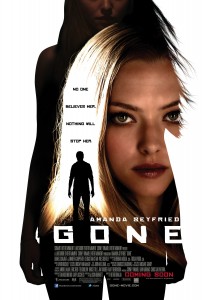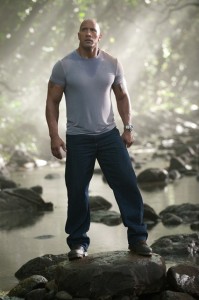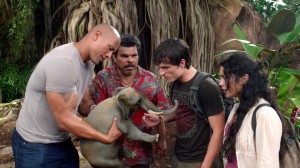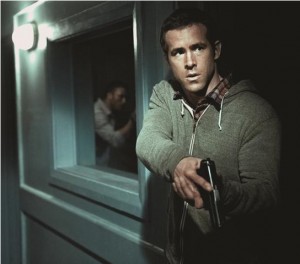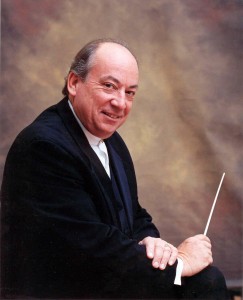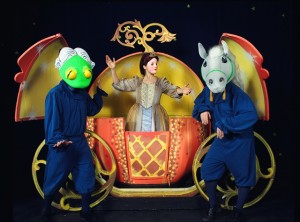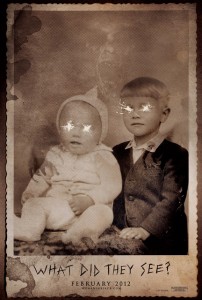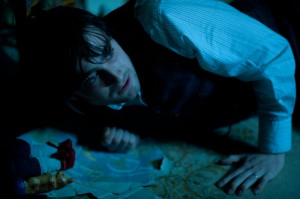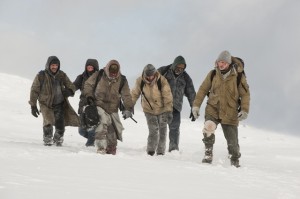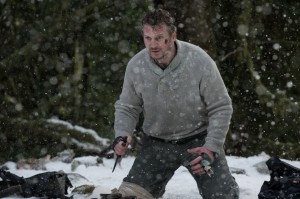By Jonathan Williams
It’s often the crazy ones that grab our attention most, right? Especially when said crazy one is also quite a talented musician. And that’s not even mentioning her visual appeal, which is equal parts Victorian femininity and a brash glam rock aesthetic.
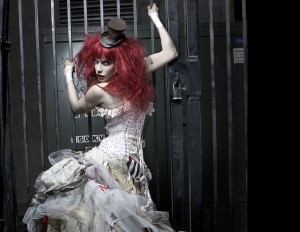 Emilie Autumn is admittedly rather odd. Actually, odd is an understatement when describing her pink-haired eccentricities and openness about the time she has spent in the modern-day equivalent of a Bedlam-like insane asylum. But rather than remain in a Girl, Interrupted-like state of depression, Autumn has been able to parlay her troubled experiences into an imaginative musical production that has evolved into something that is just as much a theatrical burlesque revue as an industrial rock concert. Along the way, her corsets and violins have appeared alongside Courtney Love (how fitting), Metalocalypse and Resistance Pro‘s Billy Corgan (you might also know him from his work with a little band called the Smashing Pumpkins).
Emilie Autumn is admittedly rather odd. Actually, odd is an understatement when describing her pink-haired eccentricities and openness about the time she has spent in the modern-day equivalent of a Bedlam-like insane asylum. But rather than remain in a Girl, Interrupted-like state of depression, Autumn has been able to parlay her troubled experiences into an imaginative musical production that has evolved into something that is just as much a theatrical burlesque revue as an industrial rock concert. Along the way, her corsets and violins have appeared alongside Courtney Love (how fitting), Metalocalypse and Resistance Pro‘s Billy Corgan (you might also know him from his work with a little band called the Smashing Pumpkins).
Currently on the Fight Like a Girl tour with her backing band the Bloody Crumpets, Autumn is introducing her fans to material from her upcoming album (also called Fight Like a Girl) with an even grander theatrical performance than you may have previously seen from her. Using her 2010 autobiography The Asylum for Wayward Victorian Girls as inspiration, Autumn’s conceptual album is being brought to life on stages across the country through Feb. 26. Amidst the insanity of this demented touring tea party, Autumn takes a moment to talk to Wrestling with Pop Culture about the tour, the album and how her bipolar disorder sometimes blurs the lines between fantasy and reality.
When I saw you in Atlanta a couple of years ago, it was your first United States tour…
Oh, that was quite a scandal. They apparently called the cops on us at some point, which was ridiculous. I think you’ll be quite surprised with our new show, not just because of how far we’ve come, but how awesome it is when we’re in a venue that isn’t being awful. When I’m not having to scream at the venue for being an idiot, everything is pretty magical.
We’ve done several European tours, where we’re much better known and much more successful. Because it’s a little bit eccentric and different, people there are quite a bit more open to it. You’re allowed to be a little bit more creative there, which is why when the Opheliac record hit, it hit in Germany and it happened very, very fast. So we did a couple of tours in Europe and the U.K. before we ever set foot back in the States. And we kind of ended up being an import, though we are from here. Of course, it’s grown a great deal since that time. But even in South America we’re far more known than we are here. It’s a very different world and that last tour was definitely a new experience for American audiences.
You’re often described as being “famously bipolar,” so I wasn’t sure if all the drama was just part of the show.
No, that was all completely legit. It is kind of funny – and I’m not ashamed of this in any way – that a large part of what I’ve fortunately been able to figure out and build a career around (so I don’t have to hide that stuff and can make use of it, not only to myself, but also to other people), is also something beautiful. That’s my ultimate revenge against the experimenting, sexual abuse and things like that is to actually make into something that is artistic and beautiful. So everything is very real, but able to be used to tell a good story.
Most people who are bipolar don’t necessarily want that to be known about them, but you choose to almost celebrate it in a lot of ways.
Yeah. Celebrate is a bit of strong word, but in a way I see why you would say that. It’s not a celebration because, God knows, like I say in my book, “no high is worth this kind of low.” It’s more about not being ashamed of it, because I’m not. Depression is serious business, but it’s something you can develop through life. Bipolar disorder is completely genetic. You’re either born with it or you’re not and there’s no getting rid of it through any amount of medication. It’s always going to be there, but it’s a matter of deciding after so much incarceration and suicide attempts, if you’re going to die or if you’re going to fight and live. What this is about is not being ashamed of it and also taking advantage of my job as an entertainer, which is one of the only jobs I could have where I wouldn’t have to completely be in shame and hide my psychological medical history.
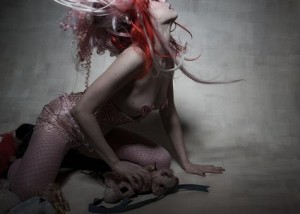 Even though it shouldn’t be this way, once it’s on the books that you’ve been locked up in an insane asylum, any legitimate job background check would find this and one would have a difficult time getting certain positions because you’re seen as mentally unstable. In the medical world, one has an extreme mental illness. That’s how’s it’s seen, so I just wanted to use my own luxury of being creative and artistic and being able to turn this into something that could help other people. I get to run around with crazy hair and paint a heart on my face every day and get away with it. As long as I’m a good entertainer, I can incorporate this into a story. The same way you didn’t know it was real or a storytelling thing, a lot of people won’t and that’s OK. But for those that do and end up identifying with it, everybody needs some compassion and something to make them feel like they are not bad because of life situations.
Even though it shouldn’t be this way, once it’s on the books that you’ve been locked up in an insane asylum, any legitimate job background check would find this and one would have a difficult time getting certain positions because you’re seen as mentally unstable. In the medical world, one has an extreme mental illness. That’s how’s it’s seen, so I just wanted to use my own luxury of being creative and artistic and being able to turn this into something that could help other people. I get to run around with crazy hair and paint a heart on my face every day and get away with it. As long as I’m a good entertainer, I can incorporate this into a story. The same way you didn’t know it was real or a storytelling thing, a lot of people won’t and that’s OK. But for those that do and end up identifying with it, everybody needs some compassion and something to make them feel like they are not bad because of life situations.
A lot of people are, in fact, made to feel like they are evil for a lot of the side effects of these things. Or just for being really individual and not the social status quo. It’s shocking that in this day and age we would even be talking about this, but it’s very, very true. There’s super scary stuff we still don’t talk about and being in this position to be this ridiculously open about it – writing a book, talking about it, singing about it – and yet not to be woefully dwelling on it. Not everything is about this. It’s more about situations and telling a good story, and the story happens to include me and my life. But it’s about something so much bigger now, this Asylum World, which is something that a lot of people have been able to come to see as, not only my sanctuary, but theirs as well. Especially when they come to the shows because it’s understood and I say, “This is a night that you come and celebrate your absolutely crazy individuality and realize how beautiful it is and don’t apologize for anything.” It’s come really far to clearly be able to send that message in a really entertaining Broadway sort of way.
That was exactly what I thought when I saw you before. It reminded me of something that might be seen on Broadway, in Las Vegas or even at Disney World.
It has become like a Broadway musical and that is actually the goal within a few years is to have a cast of 40 and have this be legitimately on a Broadway stage. It just can’t fit into rock venues any more, so this is all kind of rehearsal for that.
It’s definitely much more of a rock opera and I’m really pleased that even in that setting, which was far from ideal, that you saw that. It makes me really happy that we were able to convey that, and it’s just gotten more massive and epic, along with the new record, which was built to be part of the ultimate Broadway show that this is becoming. It needs a residency somewhere to where it isn’t just traveling around in various theaters. It’s a wonderful experience to go to all these different places, but ultimately it won’t be able to fit into a lot of the places we play. In order to have the massive sets every night and be able to do the complete show with all the fire and the aerials and all that, it’s going to need to be in a place that is at least a similar size and setup each night. It is a rock show, especially now because we have some serious rock and metal songs on the new album. But it’s all meant to be a rock opera and it’s become very evident. This tour is to be part of the three-hour musical and the record was written to be the soundtrack. It’s epic and cinematic and not meant to fall into any particular rock or industrial format.
What else can you tell me about the new album and when it will be available?
We’re performing the music on this tour and the album will come out right after this tour. I actually wanted to do this a bit backwards and I think it’s been working in a really cool way. In the past, because the Opheliac record’s been available, anywhere I’ve gone everybody has known every word to every song. So they’d sing along with us from the time we walked out. I wanted to see what it would be like if that were not the case. Like any band, we include the old favorites from the previous record, but a majority of the songs are new. So I wanted to experiment with what it would be like for people to go into a show and not know the music yet, not necessarily scream and sing along and for people to actually have to listen and learn the story along with everyone else. Of course, after the first show that wasn’t the case thanks to YouTube, but it was a nice try.
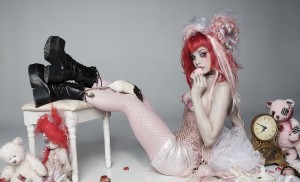 What’s the story that’s being told on the new album?
What’s the story that’s being told on the new album?
It’s called Fight Like a Girl. A lot of people abbreviate it to FLAG, which is kind of cool in its own way. It tells the story of a particular part of my book, which is like the bible of the Asylum World and me and everything I have to do with. The album and the show begins with that amazing moment when all the inmates of this Victorian insane asylum for girls, through some really extraordinary circumstances, find that they, in fact, have the power to open the main cell and release each other. So they’re all standing there realizing, “Holy fuck! There’s, like, a thousand of us and maybe 50 members of the staff. If we break out of here right now and get a hold of the weapons and tools they use on us, we become the scary ones. There’s power in numbers and the numbers are on our side.”
So they go on this rampage and have this thing called the Tea Party Massacre where they just slaughter everyone in order to gain their freedom, take back the asylum and end the years of torture. That’s how it begins, and we start with the song “Fight Like a Girl,” which really just says, “This is what’s about to happen.” Then we have a song “Time for Tea” because the clock strikes four, it’s tea time and time to go. Then they go on the warpath and take down everyone. After that we go to a flashback – in the show and on the record – of how all of this began and how this really started for me. Then my Victorian counterpart and I switch back and forth. The book is made up entirely of diary entries between myself in the modern world and my counterpart experiencing the very same things in 1841. Then we bring ourselves up through the show and the story right back where we started at the fight. That brings us to the end, after we’ve taken back this prison and tried to make it a sanctuary, the question is, “Where do we go from here? Just because we’re alive doesn’t mean that we’re living. Now that we have no one left to fight, how do we know who we are? We’ve identified with being prisoners for so long.” So it comes down to the song “One Foot In Front of the Other,” which is the answer to “How do you fucking go on with all this stuff in your head and the horrors that have happened?” The answer is that there is no answer. It’s simply one foot in front of the other foot in front of the one foot in front of the other foot. It’s a sort of march into the future that happens.
For more information, go to www.emilieautumn.com.

